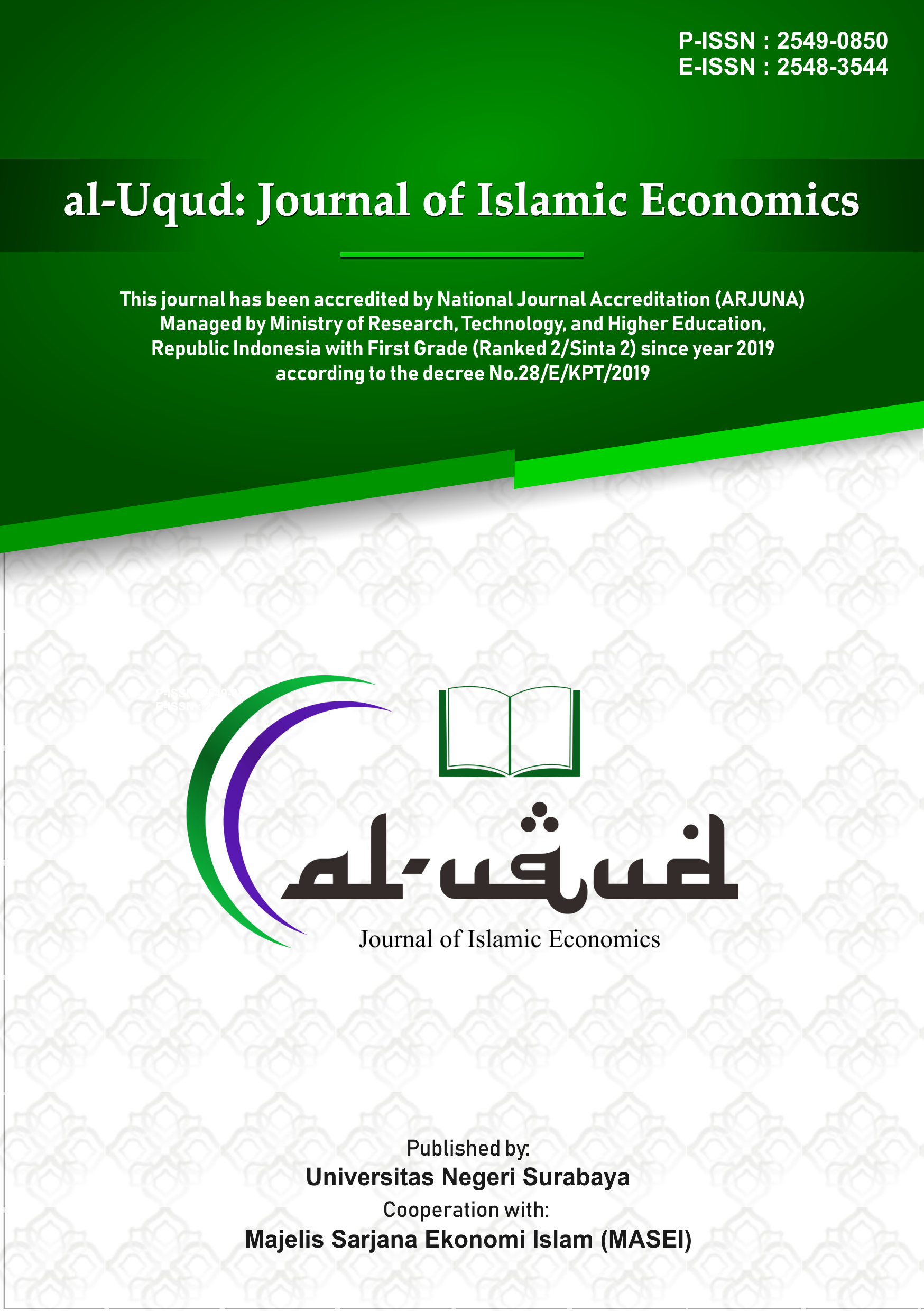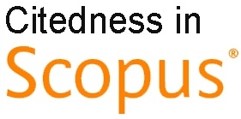Academic community's investment decision in sharia stock market: The impact of financial literacy
DOI:
https://doi.org/10.26740/aluqud.v7n1.p33-53Abstract
This study aims to determine the impact of Islamic financial literacy on the academic community at IAIN Ambon in investing in the Islamic capital market. The research methodology uses interpretive qualitative techniques. Data were collected through observation and in-depth interviews with the academic community who became informants who were determined using the purposive sampling technique. The results of the study revealed that the academic community of IAIN Ambon has high financial literacy because they received special education through investment courses and special Islamic capital markets for students, and training for lecturers and other staff, but it has not had a maximum impact on investment decisions in the Islamic capital market. The reason is that the implementation and assistance from the results of education and training are not carried out optimally. Another cause is the level of income and risk that the community thinks so that it creates boredom to invest.
References
Abbass, K., Sharif, A., Song, H., Ali, M. T., Khan, F., & Amin., N. (2022). Do geopolitical oil price risk, global macroeconomic fundamentals relate Islamic and conventional stock market? Empirical evidence from QARDL approach. Resources Policy, 77. https://doi.org/10.1016/j.resourpol.2022.102730
Alfarisi, M. F., Agestayani, A., & Delfiani, S. (2020). The Impact of Islamic Economics and Finance Courses on Islamic Financial Literacy. Iqtishadia, 13(2), 197. https://doi.org/10.21043/iqtishadia.v13i2.7757
Ani Caroline Grigion Potrich Kelmara Mendes Vieira Wesley Mendes-Da-Silva. (2016). Development of a financial literacy model for university students. Emerald Insight; Managemeny Research Review, 39(3). https://doi.org/10.1108/MRR-06-2014-0143
ANZ. (2011). ANZ Survey of Adult Financial Literacy in Australia (2011) Executive Summary. December. http://www.anz.com/resources/3/d/3dbcd380493e8b9395e5d7fc8cff90cd/2011-Adult-Financial-Literacy-Summary.pdf.pdf?MOD=AJPERES
Aryani, S. (2018). Faktor-Faktor yang Mempengaruhi Keputusan Investasi dari Mahasiswa dengan Latar Belakang Pendidikan Yang Berbeda Studi Kasus di Bandung. Jurnal Rekayasa Sistem & Industri (JRSI), 5(02), 101. https://doi.org/10.25124/jrsi.v5i01.292
Auditya, L. (2019). Peran Galeri Investasi Syariah Bursa Efek Indonesia (GIS BEI) IAIN Bengkulu dalam Meningkatkan Literasi Pasar Modal (Studi Kasus Masyarakat Sumur Dewa Air Sebakul). Al-Intaj : Jurnal Ekonomi Dan Perbankan Syariah, 5(2), 286. https://doi.org/10.29300/aij.v5i2.2060
BEI-IDX. (2021). Regional Development Information System. BEI.
Bucher-Koenen, T., Alessie, R., Lusardi, A., & van Rooij, M. (2021). Fearless Woman: Financial Literacy and Stock Market Participation. SSRN Electronic Journal, 21. https://doi.org/10.2139/ssrn.3805715
Departemen Literasi dan Inklusi Keuangan OJK. (2021). Strategi Nasional Literasi Keuangan Indonesia. Otoritas Jasa Keuangan, 378.
Direktorat Pasar Modal Syariah. (2022). Sejarah dan Pengenalan Produk Syariah di Pasar Modal. OJK.
Emmons, W. R. (2005). Saint Louis University Public Law Review Consumer-Finance Myths and Other Obstacles to Financial Literacy. 24(2).
Faidah, F. (2019). Pengaruh Literasi Keuangan Dan Faktor Demografi Terhadap Minat Investasi Mahasiswa. JABE (Journal of Applied Business and Economic), 5(3), 251. https://doi.org/10.30998/jabe.v5i3.3484
Fernando, J. (2021). Financial Literacy. Investopedia, 1.
Fu, J. (2020). Ability or opportunity to act: What shapes financial well-being? World Development, 128, 104843. https://doi.org/10.1016/j.worlddev.2019.104843
Halim, A. (2005). Analisis Investasi. PT. Salemba Emban Patria.
Hasan, M., Le, T., & Hoque, A. (2021). How does financial literacy impact on inclusive finance? Financial Innovation, 7(1). https://doi.org/10.1186/s40854-021-00259-9
Hastings, J. S., & Olivia S. Mitchell. (2011). How Financial Literacy and Impatience Shape Retirement Wealth and Investment Behaviors (No. 16740). http://www.nber.org/papers/w16740
Hung, A. A., Parker, A. M., Yoong, J. K., Parker, A. M., & Yoong, J. (2009). Defining and Measuring Financial Literacy. RAND Labor and Population.
Khotiawan, M., & Luthfiansyah, M. (2017). The Strategy to Enhance the Shariah Financial Literacy and Inclusion in Indonesia (Case Study at Financial Services Authority Office in The City of Malang). Management and Economics Journal (MEC-J), 1(1), 47. https://doi.org/10.18860/mec-j.v1i1.4529
Lusardi, A. (2008a). Household Saving Behavior: The Role of Financial Literacy, Information, and Financial Education Programs: Vol. February 2 (No. 13824; NBER Working Paper Series Household). http://www.nber.org/papers/w13824
Lusardi, A. (2008b). Nber Working Paper Series Financial Literacy: an Essential Tool for Informed Consumer Choice? http://www.nber.org/papers/w14084
Nasution, Anriza Witi, M. F. A. (2019). Analisis Faktor Kesadaran Literasi Keuangan Syariah Mahasiswa Keuangan Dan Perbakan Syariah. Equilibrium: Jurnal Ekonomi Syariah, 7(1), 40. https://doi.org/10.21043/equilibrium.v7i1.4258
Nasution, A. W., & Nasution, A. W. (2019). Analisis Faktor Kesadaran Literasi Keuangan Syariah Mahasiswa Keuangan Dan Perbakan Syariah. Equilibrium: Jurnal Ekonomi Syariah, 7(1), 40. https://doi.org/10.21043/equilibrium.v7i1.4258
OECD/INFE. (2020). Launch of the OECD/INFE 2020 International Survey of Adult Financial Literacy (Issue June).
OECD. (2020). OECD/INFE 2020 International Survey of Adult Financial Literacy. OECD/INFE 2020 International Survey of Adult Financial Literacy, 78.
OJK. (2019). Siaran Pers Survei OJK 2019: Indeks Literasi Dan Inklusi Keuangan Meningkat. Sp 58/Dhms/Ojk/Xi/2019, November, 1. https://www.ojk.go.id/id/kanal/edukasi-dan-perlindungan-konsumen/regulasi/peraturan-ojk/Documents/Pages/POJK-tentang-Peningkatan-Literasi-dan-Inklusi-Keuangan-di-Sektor-Jasa-Keuangan-Bagi-Konsumen-dan-atau-masyarakat/SAL - POJK Literasi dan Inklusi Keuang
Otoritas Jasa Keuangan. (2016). Survei Nasional Literasi dan Inklusi Keuangan 2016. Otoritas Jasa Keuangan. https://www.ptonline.com/articles/how-to-get-better-mfi-results
Otoritas Jasa Keuangan. (2022). Laporan Statistik Mingguan.
Pangestika, T., & Rusliati, E. (2019). Literasi Dan Efikasi Keuangan Terhadap Minat Mahasiswa Berinvestasi Di Pasar Modal. Jurnal Riset Bisnis Dan Manajemen, 12(1), 37. https://doi.org/10.23969/jrbm.v12i1.1524
Pangestu, S., & Karnadi, E. B. (2020). The effects of financial literacy and materialism on the savings decision of generation Z Indonesians. Cogent Business and Management, 7(1). https://doi.org/10.1080/23311975.2020.1743618
Undang-Undang Republik Indonesia Nomor 8 Tahun 1995 Tentang Pasar Modal, Presiden Republik Indonesia 1 (1995). https://doi.org/10.7312/schi13174-003
Roa, M. J., & Villegas, A. (2022). Financial Exclusion: A New Approach to the Importance of Financial Literacy.
Sabir, S. A., Javed, T., & Khan, S. A. L. I. (2021). Investment Behaviour of Individual Investors of Pakistan Stock Market with Moderating Role of Financial Literacy. Journal of Contemporary Issues in Business and Government, 27(02). https://doi.org/10.47750/cibg.2021.27.02.134
Saeedi, A., & Hamedi, M. (2018). Financial Literacy: Empowerment in the Stock Market. Palgrave macmillan. https://doi.org/10.1007/978-3-319-770
Soetiono, K. S., & Setiawan, C. (2018). Literasi dan Inklusi Keuangan Indonesia (1st ed.). Rajawali Pers.
Syafril, S. (2021). Reformulating the Applicable Strategies in Improving Financial Literacy and Inclusion Index Toward Islamic Capital Market. Jurnal Ilmiah Islam Futura, 21(1), 63. https://doi.org/10.22373/jiif.v0i0.5787
Syaifullah, M., Fachrurazi, F., Achmad, F., Usman, S. A., & Wahyuni, R. (2019). Manajemen Strategi Galeri Investasi Syariah Dalam Meningkatkan Minat Mahasiswa Untuk Berinvestasi Di Pasar Modal Syariah. Al-Mashrafiyah: Jurnal Ekonomi, Keuangan, Dan Perbankan Syariah, 3(2), 108. https://doi.org/10.24252/al-mashrafiyah.v3i2.10037
Tandelilin, E. (2017). Portofolio dan Investasi Teori dan Aplikasi. PT. Kanisius.
Tanusdjaja, H. (2018). Keputusan Investasi Investor Individu Berdasarkan Kompetensi, Overconfidence, Dan Pendidikan. Jurnal Muara Ilmu Ekonomi Dan Bisnis, 2(1), 234. https://doi.org/10.24912/jmieb.v2i1.998
Thomson Reuters. (2015). State of Glonal Islamic Economy Report 2015/16.
Westcott, R. (2016). Return on investment. Quality Progress, 49(1), 47. https://doi.org/10.4135/9781412994156.n644
Yahaya, R., Zainol, Z., Abidin, J. H. O. @ Z., & Ismail, R. (2019). The Effect of Financial Knowledge and Financial Attitudes on Financial Behavior among University Students. International Journal of Academic Research in Business and Social Sciences, 9(8). https://doi.org/10.6007/ijarbss/v9-i8/6205
Yunus, D., Rodoni, A., Prasetyowati, R., Suma, A., Ali, A., & Al-Haddad, U. (2021). Characteristics of Islamic Financial Literacy based on Demographic and Religiosity. https://doi.org/10.4108/eai.20-10-2020.2305162
Yushita, A. N. (2017). Pentingnya Literasi Keuangan Bagi Pengelolaan Keuangan Pribadi. Nominal, Barometer Riset Akuntansi Dan Manajemen, 6(1). https://doi.org/10.21831/nominal.v6i1.14330
Downloads
Published
How to Cite
Issue
Section
License

This work is licensed under a Creative Commons Attribution 4.0 International License.
CC BY 4.0 Abstract views: 1223
,
Abstract views: 1223
, PDF Downloads: 933
PDF Downloads: 933








